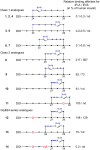Rational steering of insulin binding specificity by intra-chain chemical crosslinking
- PMID: 26792393
- PMCID: PMC4726324
- DOI: 10.1038/srep19431
Rational steering of insulin binding specificity by intra-chain chemical crosslinking
Abstract
Insulin is a key hormone of human metabolism with major therapeutic importance for both types of diabetes. New insulin analogues with more physiological profiles and better glycemic control are needed, especially analogues that preferentially bind to the metabolic B-isoform of insulin receptor (IR-B). Here, we aimed to stabilize and modulate the receptor-compatible conformation of insulin by covalent intra-chain crosslinking within its B22-B30 segment, using the Cu(I)-catalyzed Huisgen 1,3-dipolar cycloaddition reaction of azides and alkynes. This approach resulted in 14 new, systematically crosslinked insulin analogues whose structures and functions were extensively characterized and correlated. One of the analogues, containing a B26-B29 triazole bridge, was highly active in binding to both IR isoforms, with a significant preference for IR-B. Our results demonstrate the potential of chemistry-driven modulation of insulin function, also shedding new light on the functional importance of hormone's B-chain C-terminus for its IR-B specificity.
Figures




Similar articles
-
The role of the C-terminus of the insulin B-chain in modulating structural and functional properties of the hormone.Int J Pept Protein Res. 1995 Nov;46(5):397-407. doi: 10.1111/j.1399-3011.1995.tb01074.x. Int J Pept Protein Res. 1995. PMID: 8567184
-
Human insulin analogues modified at the B26 site reveal a hormone conformation that is undetected in the receptor complex.Acta Crystallogr D Biol Crystallogr. 2014 Oct;70(Pt 10):2765-74. doi: 10.1107/S1399004714017775. Epub 2014 Sep 27. Acta Crystallogr D Biol Crystallogr. 2014. PMID: 25286859 Free PMC article.
-
Insulin receptor structure and its implications for the IGF-1 receptor.Curr Opin Struct Biol. 2007 Dec;17(6):699-705. doi: 10.1016/j.sbi.2007.07.007. Epub 2007 Sep 11. Curr Opin Struct Biol. 2007. PMID: 17851071 Review.
-
Engineering of insulin receptor isoform-selective insulin analogues.PLoS One. 2011;6(5):e20288. doi: 10.1371/journal.pone.0020288. Epub 2011 May 20. PLoS One. 2011. PMID: 21625452 Free PMC article.
-
Molecular mechanisms of differential intracellular signaling from the insulin receptor.Vitam Horm. 2009;80:51-75. doi: 10.1016/S0083-6729(08)00603-1. Vitam Horm. 2009. PMID: 19251034 Review.
Cited by
-
Contribution of TyrB26 to the Function and Stability of Insulin: STRUCTURE-ACTIVITY RELATIONSHIPS AT A CONSERVED HORMONE-RECEPTOR INTERFACE.J Biol Chem. 2016 Jun 17;291(25):12978-90. doi: 10.1074/jbc.M115.708347. Epub 2016 Apr 26. J Biol Chem. 2016. PMID: 27129279 Free PMC article.
-
Insulin Receptor Isoforms in Physiology and Disease: An Updated View.Endocr Rev. 2017 Oct 1;38(5):379-431. doi: 10.1210/er.2017-00073. Endocr Rev. 2017. PMID: 28973479 Free PMC article. Review.
-
A radioligand binding assay for the insulin-like growth factor 2 receptor.PLoS One. 2020 Sep 2;15(9):e0238393. doi: 10.1371/journal.pone.0238393. eCollection 2020. PLoS One. 2020. PMID: 32877466 Free PMC article.
-
Optimized syntheses of Fmoc azido amino acids for the preparation of azidopeptides.J Pept Sci. 2017 Mar;23(3):202-214. doi: 10.1002/psc.2968. Epub 2017 Jan 25. J Pept Sci. 2017. PMID: 28120383 Free PMC article.
-
Probing Receptor Specificity by Sampling the Conformational Space of the Insulin-like Growth Factor II C-domain.J Biol Chem. 2016 Sep 30;291(40):21234-21245. doi: 10.1074/jbc.M116.741041. Epub 2016 Aug 10. J Biol Chem. 2016. PMID: 27510031 Free PMC article.
References
-
- Taniguchi C. M., Emanuelli B. & Kahn C. R. Critical nodes in signalling pathways: insights into insulin action. Nat. Rev. Mol. Cell Biol. 7, 85–96 (2006). - PubMed
-
- Cohen P. Timeline - the twentieth century struggle to decipher insulin signalling. Nat. Rev. Mol. Cell Biol. 7, 867–873 (2006). - PubMed
-
- Ward C. W., Menting J. G. & Lawrence M. C. The insulin receptor changes conformation in unforeseen ways on ligand binding: sharpening the picture of insulin receptor activation. Bioessays 35, 945–954 (2013). - PubMed
-
- Seino S. & Bell G. I. Alternative splicing of human insulin receptor messenger RNA. Biochem. Biophys. Res. Commun. 159, 312–316 (1989). - PubMed
Publication types
MeSH terms
Substances
Grants and funding
LinkOut - more resources
Full Text Sources
Other Literature Sources
Medical

